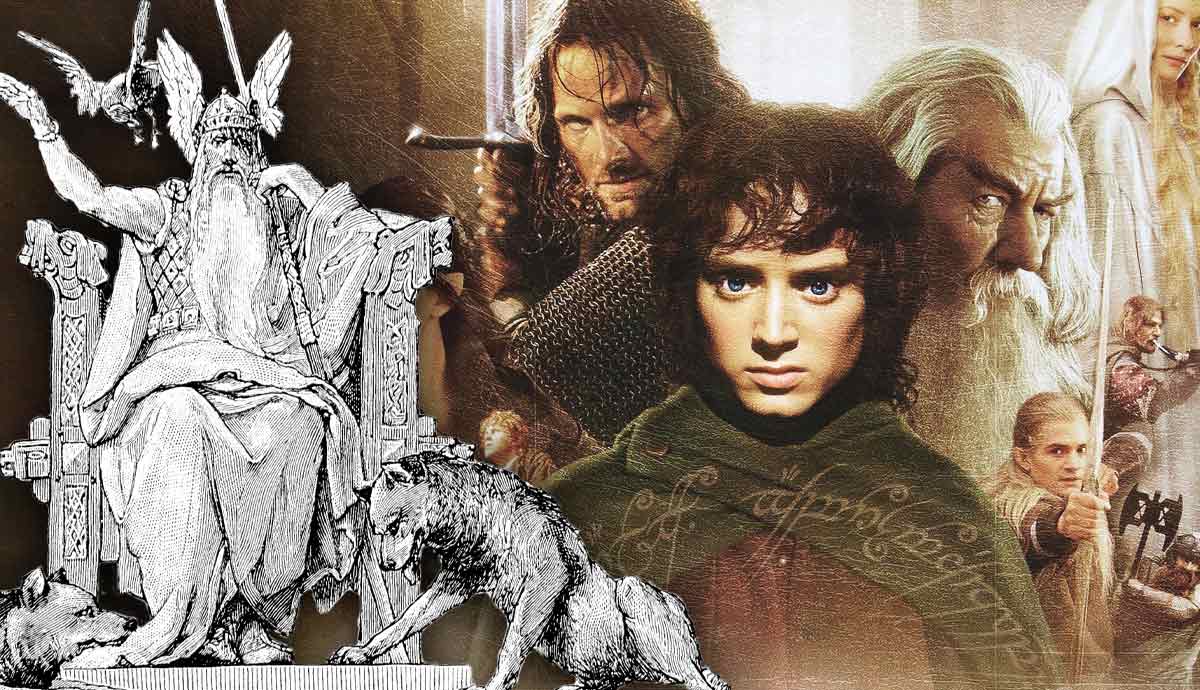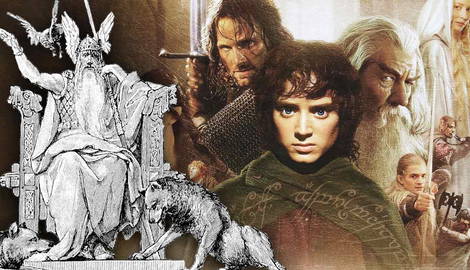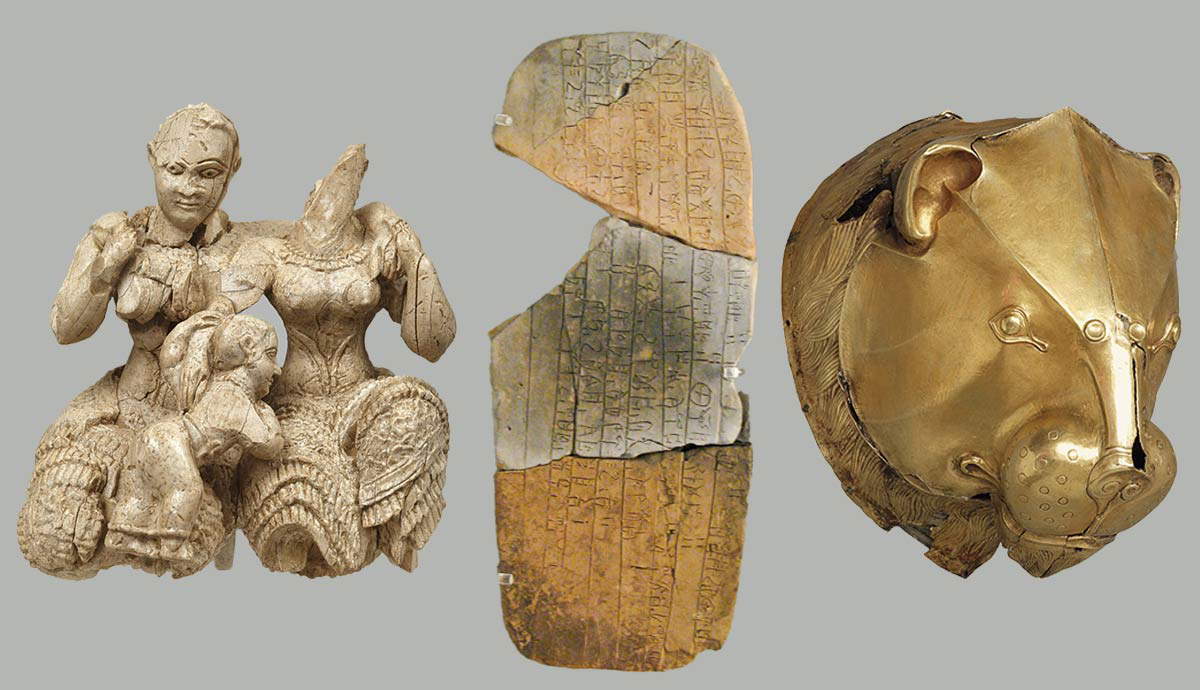
J.R.R. Tolkien’s legendary works set within the realm of Middle Earth were heavily inspired by Norse mythology. His elves and dwarves are plucked directly from the Norse cosmos, and Gandalf is inspired by none other than Odin the All-Father, the most important Viking deity. Even Tolkien’s One Ring is inspired by the Norse story of the cursed ring Andvaranaut.
It is perhaps no surprise that elements of Norse mythology inspired Tolkien’s creation of his rich fantasy world. As well as being a founding member of the Inklings, Tolkien also founded the Leeds Viking Club in the 1920s.
Tolkien’s Interest in Norse Mythology

John Ronald Reuel Tolkien was born in England in 1892 and became famous for writing The Hobbit, The Lord of the Rings, and several other books set in the same fantasy universe. He studied classics and then English language and literature at Oxford University, and when he graduated in 1915, he joined the British Army.
Tolkien’s experiences in World War I would mark the author and greatly influence his writings. He participated in the Battle of the Somme in 1916, where he became very ill. This resulted in him being sent back to England and spending the rest of the war in hospitals and garrisons.
Back in his life in academia, he worked at the University of Leeds before coming back to Oxford where he worked until his retirement in 1959. He specialized in English and Anglo-Saxon literature, and he started to write his now-famous works. He was also a founding member of The Inklings club with fellow fantasy writers at Oxford, including C.S. Lewis.
So, where did Tolkien’s interest in Norse mythology begin? Well, in the 1920s he completed a translation of the Old English poem, Beowulf. While written in Old English, the poem is about a 6th-century Danish hero. When he returned from the war, he worked for the Oxford English Dictionary, specializing in German etymology.
While still at the University of Leeds, Tolkien founded The Viking Club, where interested parties could talk about extinct Germanic languages and culture. Tolkien further pursued his interest by writing his own version of the Norse Legend of Sigurd and Gudrun. This included the Norse story of the cursed ring Andvaranaut. But the cursed ring is just one of the many elements of Norse mythology that would find its way into Tolkien’s fictional works.
Norse Cosmology and the Creation of Middle Earth

Tolkien’s works stand out for their setting — a complex and coherent fantasy world with its own extensive mythology. The cosmology that Tolkien created was certainly inspired, in part, by the cosmology of the Norse universe.
This starts with Middle Earth itself, which is the realm of mortal men in Tolkien’s universe. This seems to be inspired by Midgard, a realm created by the Norse god Odin and his brothers, who then created men to populate the world. The gods protect Midgard from chaotic forces from their home, Asgard.
In Tolkien’s universe, the divine Valar live in Valinor. This seems to be inspired by Asgard as Valinor is connected to Middle Earth by a long straight land bridge similar to the Rainbow Bifrost Bridge that connects Asgard and Midgard.
Within Midgard itself, Tolkien’s dark and dangerous fictional forest of Mirkwood is inspired by the Mirkwood of the Poetic Edda, which is a forest between Asgard and Muspelheim, the realm of the fire giants. Tolkien may also have been inspired by the Norse Ironwood that seems to have separated Midgard and Jotunheim, the world of the giants. It was occupied by clans of giant wolves led by the giantess Angrboda. Tolkien’s terrifying Wargs may be inspired by these wolf packs.
Meduseld, the golden mead hall of the kings of Rohan, seems to be directly inspired by Heorot, the mead hall described in Beowulf. Both halls are described as having a roof of straw that gleams like gold. When Legolas describes Meduseld, he uses a direct quote from the Old English poem saying the “light of it shines far over the land.”
When the fellowship arrives at the hall, they must discard their weapons before entering. This echoes what happens when the heroes of Beowulf arrive at Heorot and are forced to pile their weapons up at the door.
The Inhabitants of Middle Earth

Many of the inhabitants of Middle Earth are also inspired by beings that exist in Norse mythology and Scandinavian folklore. The most obvious of these are Tolkien’s elves and dwarves.
Norse mythology has two different groups of elves, called Light Elves and Dark Elves. The Light Elves are described as angelic and magical beings with a supernatural connection to nature. It is often difficult to draw clear lines between the elves and the gods. These creatures inspired Tolkien’s elves.
The Dark Elves are the inspiration for Tolkien’s dwarves. In Norse mythology, the dark elves are said to live underground in caves and workshops, and they are the master blacksmiths of the Norse cosmos. They made many of the great treasures in the Norse universe, including Thor’s hammer Mjolnir.
To cement this connection further, the complex language that Tolkien created for his dwarves was based on the Old Norse runes. Meanwhile, Tolkien’s common Elvish language was based on Welsh and other Celtic languages, while High Elven (Quenya) was based on Finnish with Latin and Greek elements.

The names of all the dwarves that we meet in The Hobbit are also inspired by the names of dwarves listed in the Voluspa Saga, the story of the creation and destruction of the world told by the Volva witch to Odin. Bifur, Bofur, Bombur, Dwalin, Oin, Gloin, Dori, Nori, Ori, Fili, and Kili are all Norse dwarves. And of course, there is Thorin Oakenshield.
Even Frodo’s name comes from the Ynglinga Saga, which records a mythical prehistory of Scandinavia. Frodi is a Danish king descended from Odin, who rules over the country during a period of peace and prosperity and is described as so honest that he would never steal a ring.
Tolkien’s trolls are also inspired by Scandinavian folklore, in which trolls are believed to live under bridges and at other crossroads. But they also borrow from the Norse mythology surrounding the dwarves. In one story, Thor becomes angry that a dwarf has the audacity to ask for the hand of his daughter, Thrudr, in marriage. He tricks the dwarf into talking with him for the entire night so that he loses track of time and turns to stone when the sun rises. Gandalf uses a similar strategy to deal with the trolls in The Hobbit.
Gandalf as Odin

Gandalf is the name of a dwarf found in the Volsupa Saga, but Tolkien himself stated in a letter that he wrote in 1946 that Gandalf was also inspired by the idea of the Odinic Wanderer. Odin was the most important of the Norse gods. He was the god of war, wisdom, witchcraft, and writing. While Odin had a high seat in Asgard from where he could look out over the cosmos, he often chose to abandon this seat and walk among mortals in disguise as a wanderer. When he did, he looked like an old man with a great beard and a brimmed hat, just like Gandalf.
Gandalf is one of the Valar, a god-like race that lives in Valinor. But he spends his life wandering Middle Earth, guiding the course of events.
We see another Norse motif when Gandalf faces the Balrog in Moria. The Balrog is a fire demon that is based on Surtr, a great fire giant that is destined to burn much of the world at Ragnarök, the Norse foretelling of the end of the world. The battle between Gandalf and the Balrog seems to represent an imagined fight between Odin and Surtr on the Rainbow Bifrost Bridge. According to the Ragnarök prophecy, the Bifrost Bridge is destined to crumble under the weight of the giants in the final battle.
Several other Tolkien characters can also be linked to Norse mythology, including Beorn, who has a Viking name and can transform into a bear like a berserker warrior, and the hero Turin Turambar from The Silmarillion, who seems to be based on Sigurd, the hero who kills the dragon Fafnir.
What About the One Ring?

What about the most important motif in Tolkien’s work, the one ring? Can it be related to Norse mythology? As mentioned above, Tolkien wrote a version of the adventures of the Viking heroes Sigurd and Gudrun, which contained the story of the Andvaranaut, a cursed ring. Incidentally, the same stories inspired Wagner’s Der Ring des Nibelungen, which Tolkien reportedly hated, considering it fascist propaganda.
In the story, a dwarf named Andvari is a shapeshifter who can turn into a fish and enjoys swimming. One day he encounters a group of water nymphs, who laugh at him, so he steals their enchanted treasure. Like most dwarves, he is a master craftsman and uses some of their treasure to make a magnificent golden ring for himself, called Andvaranaut. It is also enchanted to ensure his treasure always grows, so he can spend his time swimming and admiring his wealth. He seems not unlike the version of Gollum we meet in The Hobbit.
One day, Odin, Hoenir, and Loki are traveling to meet the dwarven king Hreidmar, and they stop at Andvari’s river. Loki sees Andvari and his treasure, but he also sees a handsome otter. He kills it and skins it for its pelt, which he intends to give to the dwarven king as a gift. But when the trio arrives and the king sees the pelt, he is horrified. His sons can also shapeshift, and one of them becomes a handsome otter. It is his pelt.

The gods agree to pay a ransom for the death and to cover every millimeter of the pelt with gold. Loki returns to the river to retrieve the gold he saw there to pay the price. He catches Andvari in fish form and demands the gold in exchange for his life. Andvari begs Loki to just leave him the ring, but Loki refuses. Therefore, Andvari curses the ring to bring its owner great wealth, but also devastation.
Loki initially intends to keep the ring for himself, but when a small part of the pelt seems to be uncovered, he must use the ring to complete the ransom.
The dwarven king immediately becomes obsessed with his new treasure, especially the ring. He refuses to share it with his two other sons, Regin and Fafnir. Eventually, Fafnir kills his father and drives his brother from their keep. Fafnir then permanently shapeshifts into a dragon so that he can protect his treasure.
Fafnir seems to be the inspiration for Tolkien’s dragon Smaug. The small hole in Smaug’s armored scales may also be inspired by the tiny part of the pelt that was not covered in gold and forced Loki to hand over the ring.

Later, Regin is living in a human village and meets the young hero Sigurd. Sigurd has brought the smith his father’s broken sword, Garm, so that it may be reforged. This is reflected in the Elves reforging Narsil, the sword of the kings of Gondor, as Anduril for Aragorn.
Regin convinces Sigurd to kill Fafnir for him and bring him the ring, which Sigurd does. But as he is returning with the prize, Sigurd learns that Regin intends to kill him, so he kills Regin and keeps the ring. Like the One Ring, the Andvaranaut has an ownership history based on death and blood. Sigurd himself meets a bloody end when he is killed by his friend Gudrun.
This is not the only special ring that appears in Norse mythology. Odin also possessed a special gold ring forged for him by the dwarves. Called Draupnir, which means “dripper,” every nine days it produced eight rings equally as fine, ensuring Odin’s continued wealth. While Tolkien’s lesser rings are clearly much more complex than these copies, the idea of a ring begetting and controlling other rings may have started here.
Interestingly, one of the kennings for Draupnir is “precious sweat.” Perhaps this inspired the etymologist Tolkien to have Gollum call the One Ring “my precious.”










